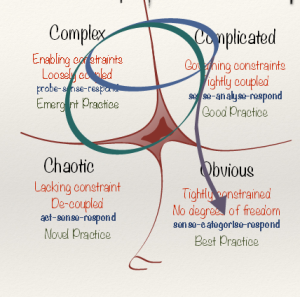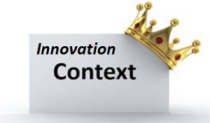 I recently wrote a post “Finding knowledge and research to help you learn and adapt”.
I recently wrote a post “Finding knowledge and research to help you learn and adapt”.So I’ve chosen two that challenge and break ground.
Continue reading “Deeper read or quick summary? Depends on the time we have.”
Building Your Innovation Intelligence
Bringing my thinking and solutions to your problems
 I recently wrote a post “Finding knowledge and research to help you learn and adapt”.
I recently wrote a post “Finding knowledge and research to help you learn and adapt”. “The world has never been as complex, dynamic and uncertain as it is today and the pace of change will only increase.”
“The world has never been as complex, dynamic and uncertain as it is today and the pace of change will only increase.”
How often do you pause for thought, testing yourself, questioning even simply for ‘just those few minutes,’ to allow yourself to openly challenge where you are and what you are attempting to do?
We keep relentlessly moving on, like a wandering herd of buffalo, always looking for fresh pasture, those new feeding grounds. It’s not good.
Of course, I often get caught up in this restless pursuit of gathering more, when I spend a growing amount of my time researching innovation. I keep coming across so many things that ‘trigger’ the thinking, pushing me on.
Do you let them go, ignore them, quickly pass over them, or attempt to capture the issue as something well worth investigating further at a later stage, or just get them simply behind you in the here and now.
Continue reading “Walkabouts are needed for learning and testing ourselves”

We need to think differently about innovation and why it needs complexity and adaptive thinking as part of its design.
Complexity within systems challenge us to think differently, it pushes us to think outside often our normal experiences, to confront and understand and then restructure, often the unordered, into a new order.
Organizations are in need of understanding the complexities within their systems far more.
Complexity within innovation is always adaptive.
The challenge with managing complexity is that it is made up of many shifting and connected parts, that form much around interactions and relationships. These new ‘connections’ are shifting and challenging much of our previous understanding, built often on past practice and entrenched thinking.
Continue reading “Understanding Challenges Within Innovation Complexity”

Firstly a very brief explanation of the Cynefin Model and why I find it highly valuable for innovation management.
Innovation has many characteristics of a complex adaptive system as I have crudely attempted to explain here.
The three primary states within the Cynefin framework are Ordered Systems (including Obvious and Complicated), Complexity and Chaos.
Order is split into two, as this handles a key difference in human knowledge between those states, where the cause and effect relationship is obvious and those where it requires greater analysis or expertise.
Exploring a process of emergent discovery for innovation
Most innovators are working in and certainly are far more familiar with the ordered domains, for ‘obvious’ innovations that extend, enhance or evolve their existing products and services.
Equally, they understand their more specialised place and contribution to be growing in their comfort, in the part they play in the more ‘complicated’ domain, where expertise, dedicated focus and specialization are often required or called upon.
Continue reading “The Use of the Cynefin Model for Innovation Management”
 Today we face unprecedented change; organizations are being hit on multiple sides, often by a bewildering set of forces to make them feel the immediate need is to go back into themselves, to be more inward than looking out and being open to facing the future. There is this feeling today of being battered. Organizations are feeling the full force of the winds of business and global change.
Today we face unprecedented change; organizations are being hit on multiple sides, often by a bewildering set of forces to make them feel the immediate need is to go back into themselves, to be more inward than looking out and being open to facing the future. There is this feeling today of being battered. Organizations are feeling the full force of the winds of business and global change.
Stopping, reflecting and then moving on.
Organizations are grappling with how to navigate through an unprecedented set of early 21st century challenges. How can they adjust to a more open and transparent world, a more fluid and adaptive one, that needs to be replacing the one we have been operating within all of the last century? One that seems to work no more as its very foundations seem to be crumbling. Organizations are in a period of relearning and understanding these ‘new’ forces at work. Continue reading “Facing the future or staying locked in the slow lane of the past?”
 We have all got used to the statement it is all about “location, location, location” for real-estate. So what should the mantra be for innovation? I think “context, context and context”. Context is a king.
We have all got used to the statement it is all about “location, location, location” for real-estate. So what should the mantra be for innovation? I think “context, context and context”. Context is a king.
Innovation happens all around us, same as with our places where we live- it is determined by many factors but given a choice we want to live somewhere nice, safe and hopefully going up in value!
The same with innovation we want it to be good, attractive, useful and valued by many, hopefully, willing to part with their money because it fulfils their need.
Innovation should always start of by being placed in its appropriate context otherwise it will lose its initial connection, dilute in the eventual value and arrive as less desirable because we somehow and somewhere went off track
We lost the context because we never really established the real ‘sense of purpose’ for that specific innovation or given direction to explore.
Why do I believe context is the king when it comes to innovation?
Continue reading “Learning the mantra of innovation context”
I’ve always loved this: “appropriate adaptiveness is not a natural tension- it has to be designed.” OK, I can hear you quietly sniggering.
When you are dealing with the innovation process you naturally have tension. Often if you have no tension or simply too much slack built into the process, you don’t end up in achieving a good result. Results fall well below expectations.
It is often this lack of designed-in ‘tension’ that is not appreciated like it should be within the innovation process. The wrong tension is left to eat away at the innovation process. Getting the right balance of tension is critical to get the best out of the ‘system’ of innovation.
Firstly a cautionary warning here.
Now this is about to get into the realms of theory but I hope you stay with me on this. Why? Well knowing why innovation does fail can be useful (to your future) and what you can design into it, so as to reduce this risk has some value, I would think. So tune out or hang in, it is your choice. Continue reading “Designing appropriate tension into the innovation process.”